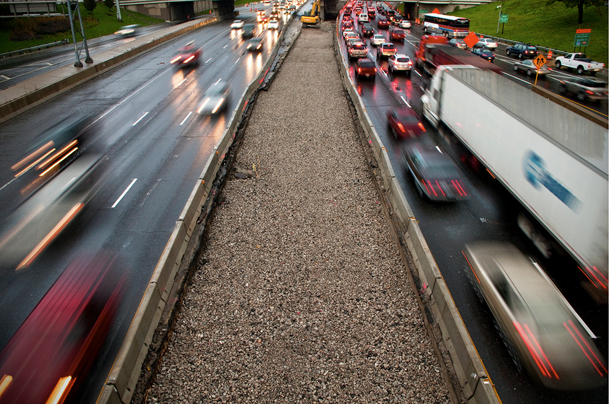Traffic congestion’s carbon footprint
By Chris Bentley

Traffic congestion’s carbon footprint
By Chris Bentley
Traffic congestion produced 56 billion pounds of carbon dioxide (CO2) pollution in 2011 — roughly equivalent to the emissions from the electricity use of 3.8 million homes for one year — according to the Texas A&M Transportation Institute’s Urban Mobility Report released Tuesday.
While the report’s main innovation was a new metric that predicted the unpredictably of metro area traffic, it also included for the first time an estimate of the additional CO2 emissions attributed to traffic congestion. That does not include emissions from cars traveling when roadways are uncongested.
Transportation is responsible for roughly one third of U.S. carbon emissions, making it the second largest-emitting sector (behind electricity generation). Worldwide transportation represents 20 percent of total energy consumption.
It is difficult to measure congestion’s contribution to national carbon emissions — estimates are sensitive to highly variable factors like driving behavior, vehicle and roadway types, and local traffic conditions —but the report’s stab at quantifying the issue could help further visualize a largely ignored pollution problem.
Noted climate scientist Richard Alley has pointed out that if the roughly 1 pound of CO2 per mile that cars emit were “horse ploppies,” instead of invisible gas, every road in the country would be underneath an inch of poop within one year.
“Fuel wasted in congested traffic reached a total of 2.9 billion gallons — enough to fill the New Orleans Superdome four times,” the report reads. That is the same as in 2010, but less than the 3.2 billion gallons wasted in 2005.
There are a few key ways to improve the fuel efficiency of cars. Scientists and engineers are working on lighter vehicles, more efficient engines, and engines that run on alternative fuels. But advocates of policy solutions say just changing driving patterns can also have a significant impact.
The Chicago Metropolitan Agency for Planning touts congestion pricing as one such intervention, citing long-term economic impacts to boot — CMAP’s Jesse Elam talked about their plan on The Afternoon Shift.
Research out of the University of California at Riverside, which has its fair share of traffic, found metering ramp entry, lowering average driving speeds to 55 mph and reducing traffic congestion through variable speed limits could each potentially lower CO2 emissions 7 to 12 percent. The combined effects of one or more of these changes could be greater, their report said.
“Including CO2 emissions into the [Urban Mobility Report] provides another dimension to the urban congestion problem,” said researcher and co-author David Schrank in a press release. “It points to the importance of implementing transportation improvements to reduce congestion.”
Researchers said they plan to include more metrics of air quality in future reports.
